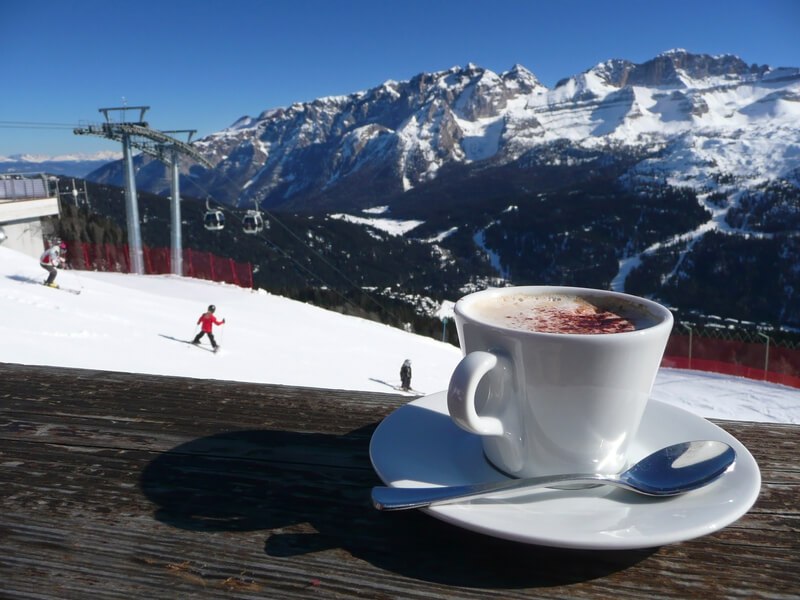According to UN trade statistics, the small Alpine nation exported US$ 2.4 billion1 of coffee in 2013. This figure is far higher than its cheese (US$ 615 million2) or chocolate (US$ 822 million3) exports, two far more famous Swiss exports. © Hpphoto | Dreamstime.com In 2013, Swiss coffee exports ranked 4th behind Brazil (.3b), Germany (.4b) and Vietnam (.9b). Ethiopia, where the coffee plant originated, trailed back in 13th place with 1 million of exports. And Italy, the European nation where even ordinary eateries can produce a near perfect shot, ranked 7th, with exports of .4 billion. Switzerland and Germany were the only exporters in the top five that weren’t also among the top five coffee growing nations. So what is going on? Viewed by weight the picture is different. In 2013, Switzerland processed only 131 million kgs4 of raw green coffee beans. Italy, which exported 42% less, processed 495 million kgs4 of raw beans, close to four times as much. But, Switzerland’s end product is pricier, pushing up the value of what it exports. Food giant Nestlé has three factories in Switzerland churning out Nespresso capsules. Each of these contains 5-6 grams of coffee and sells for US$ 0.56 (CHF 0.57). Gram for gram the coffee in these capsules costs around 10 times as much as coffee from a typical bag of roasted beans.
Topics:
Investec considers the following as important: Business & Economy, Editor's Choice, Swiss coffee, Swiss coffee brands, Swiss coffee exports
This could be interesting, too:
Investec writes Swiss to vote on tenancy laws this weekend
Investec writes Switzerland ranked second in digital competitiveness
Investec writes Swiss wages set to rise in 2025
Investec writes Federal Council hopes to boost savings with pension change
According to UN trade statistics, the small Alpine nation exported US$ 2.4 billion1 of coffee in 2013. This figure is far higher than its cheese (US$ 615 million2) or chocolate (US$ 822 million3) exports, two far more famous Swiss exports.

© Hpphoto | Dreamstime.com
In 2013, Swiss coffee exports ranked 4th behind Brazil ($5.3b), Germany ($3.4b) and Vietnam ($2.9b). Ethiopia, where the coffee plant originated, trailed back in 13th place with $771 million of exports. And Italy, the European nation where even ordinary eateries can produce a near perfect shot, ranked 7th, with exports of $1.4 billion. Switzerland and Germany were the only exporters in the top five that weren’t also among the top five coffee growing nations.
So what is going on?
Viewed by weight the picture is different. In 2013, Switzerland processed only 131 million kgs4 of raw green coffee beans. Italy, which exported 42% less, processed 495 million kgs4 of raw beans, close to four times as much.
But, Switzerland’s end product is pricier, pushing up the value of what it exports. Food giant Nestlé has three factories in Switzerland churning out Nespresso capsules. Each of these contains 5-6 grams of coffee and sells for US$ 0.56 (CHF 0.57). Gram for gram the coffee in these capsules costs around 10 times as much as coffee from a typical bag of roasted beans.
In addition, Switzerland is smaller and consumes a lot less of what it makes, leaving more for export – there are 60 million Italians and only 8 million Swiss.
Switzerland’s oversized share of the coffee trade is relatively new. In 2005, Switzerland exported only US$130 million of coffee, eight years later it was US$ 2.4 billion. Over the same period Nespresso’s sales rose more than 5-fold. Other Swiss coffee capsule producers, such as the Ethical Coffee Company, have added further to pricey Swiss coffee capsule exports.
Since 2013, Swiss coffee exports have been stable. In 2015, Switzerland exported US$ 2.2 billon5, placing it 5th after the same nations above, plus Columbia.
US$2.2 billion. By George6 that’s a lot of coffee.
More on this:
1UN Comtrade coffee export numbers 2013 – opens PDF (in English)
2UN Comtrade chocolate export numbers 2013 – opens PDF (in English)
3UN Comtrade cheese export numbers 2013 – opens PDF (in English)
4European Coffee Report 2013-14 – opens PDF (in English)
5UN Comtrade coffee export numbers 2015 – opens PDF (in English)
6Clooney
